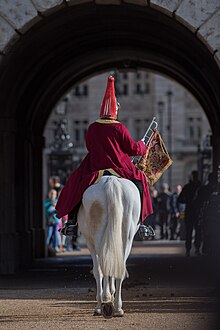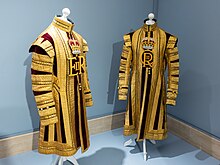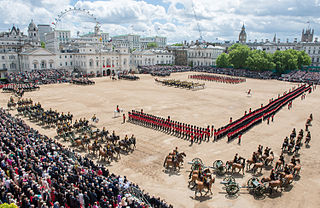
Trooping the Colour is a ceremonial event performed every year on Horse Guards Parade in London, United Kingdom, by regiments of Household Division, to celebrate the official birthday of the British sovereign. It is also known as the Sovereign's Birthday Parade. Similar events are held in other countries of the Commonwealth. In the UK, it is, with the State Opening of Parliament, one of the biggest events of the ceremonial calendar, and watched by millions on TV and on the streets of London.
The Household Cavalry (HCAV) is a corps of the Household Division, made up of the two most senior regiments of the British Army, The Life Guards and The Blues and Royals. These regiments are divided between the Household Cavalry Regiment stationed at Wing Barracks in Wiltshire, with an armored reconnaissance role, and the ceremonial mounted unit, the Household Cavalry Mounted Regiment, garrisoned at Hyde Park Barracks in London. Both the HCMR and HCR are made up of elements of the Life Guards and the Blues and Royals. The Household Cavalry is part of the Household Division and is the King's official bodyguard. Although the Household Cavalry Regiment is armoured, it is not part of the Royal Armoured Corps, being assigned to the Household division.
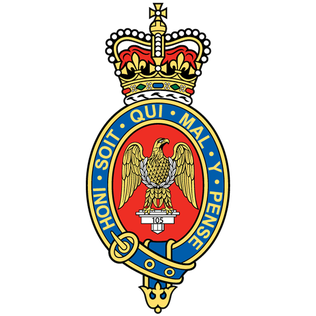
The Blues and Royals (RHG/D) is a cavalry regiment of the British Army, part of the Household Cavalry. The Colonel of the Regiment is Anne, Princess Royal. It is the second-most senior regiment in the British Army.

The Governor General's Horse Guards is an armoured cavalry regiment in the Primary Reserve of the Canadian Army. The regiment is part of 4th Canadian Division's 32 Canadian Brigade Group and is based in Toronto, Ontario. It is the most senior reserve regiment in Canada, and the only household cavalry regiment of Canada's three household units.
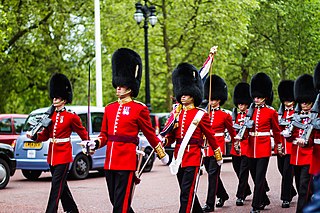
The King's Guard are sentry postings at Buckingham Palace and St James's Palace, organised by the British Army's Household Division. The Household Division also mounts sentry postings at Horse Guards, known as the King's Life Guard.
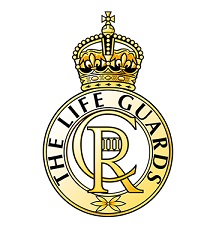
TheLife Guards (LG) is the most senior regiment of the British Army and part of the Household Cavalry, along with The Blues and Royals.

Busby is the English name for the Hungarian prémes csákó or kucsma, a military head-dress made of fur, originally worn by Hungarian hussars. In its original Hungarian form the busby was a cylindrical fur cap, having a bag of coloured cloth hanging from the top. This bag could be filled with sand and the end attached to the right shoulder as a defence against sabre cuts.
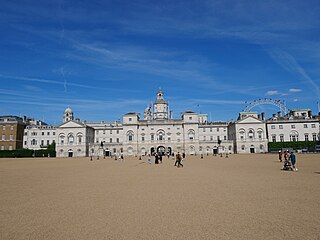
Horse Guards is a historic building in the City of Westminster, London, between Whitehall and Horse Guards Parade. It was built in the mid-18th century, replacing an earlier building, as a barracks and stables for the Household Cavalry. The current and previous buildings were, between the early 18th century and 1858, the main military headquarters for the British Empire. Horse Guards originally formed the entrance to the Palace of Whitehall and later St James's Palace; for that reason it is still ceremonially defended by the King's Life Guard.
The Blue Hussars, known officially as the Mounted Escort, was a ceremonial cavalry unit of the Irish Army established in 1932. It escorted the President of Ireland on state occasions, most famously to and from presidential inaugurations between 1938, when the first President assumed office, and 1948, when the Escort was disbanded.
The Household Cavalry Mounted Regiment (HCMR) is a cavalry regiment of the British Army tasked primarily with ceremonial duties. Part of the Household Division, it is classed as a regiment of guards, and carries out mounted ceremonial duties on State and Royal occasions. The HCMR is one of two operational units that form the Household Cavalry (HCav), the other being the Household Cavalry Regiment (HCR), a formation reconnaissance regiment, with front-line combat duties.

Full dress uniform, also known as a ceremonial dress uniform or parade dress uniform, is the most formal type of uniforms used by military, police, fire and other public uniformed services for official parades, ceremonies, and receptions, including private ones such as marriages and funerals. Full dress uniforms typically include full-size orders and medals insignia. Styles tend to originate from 19th century uniforms, although the 20th century saw the adoption of mess dress-styled full-dress uniforms. Designs may depend on regiment or service branch. In Western dress codes, full dress uniform is a permitted supplementary alternative equivalent to the civilian white tie for evening wear or morning dress for day wear – sometimes collectively called full dress – although military uniforms are the same for day and evening wear. As such, full dress uniform is the most formal uniform, followed by the mess dress uniform.

The uniforms of the British Army currently exist in twelve categories ranging from ceremonial uniforms to combat dress. Uniforms in the British Army are specific to the regiment to which a soldier belongs. Full dress presents the most differentiation between units, and there are fewer regimental distinctions between ceremonial dress, service dress, barrack dress and combat dress, though a level of regimental distinction runs throughout.

The Regiment of Mounted Grenadiers "General San Martín" is the name of two Argentine Army regiments of two different time periods: a historic regiment that operated from 1812 to 1826, and a modern cavalry unit that was organized in 1903.

The Royal Artillery Mounted Band was a British military band consisting of woodwind, brass, and percussion instruments, and military unit, founded in 1886, and in existence until 1984, representing the Royal Artillery, and the Royal Horse Artillery, and augmenting the Royal Artillery Band at royal and state occasions.

The Royal Artillery Band was the first official, and permanent British military band originating in 1557, but granted official status in 1762. Consisting of woodwind, brass, and percussion instruments, it represented both the Royal Regiment of Artillery, and the state. The Royal Artillery Orchestra [disbanded on 9 February 2014] was Britain's first permanent professional orchestra. All other bands in the British Army received official, permanent status from 1763 onward. Now that the band's overall history of over four and a half centuries has come to an end, it is now claimed that the Band of the Grenadier Guards are the oldest band, with their overall history of over three hundred and thirty years. It is however, important to consider that until 1762, all military bands were formed as and when required, and then immediately disbanded when not, and that they consisted only of hired, civilian musicians; becoming integrated professional soldiers in 1762 and from 1763.

A fanfare trumpet, also called a herald trumpet, is a brass instrument similar to but longer than a trumpet, capable of playing specially composed fanfares. Its extra length can also accommodate a small ceremonial banner that can be mounted on it.

A mounted band is a military or civilian musical ensemble composed of musician playing their instruments while being mounted on an animal. The instrumentation of these bands are limited, with the musician having to play their instrument, as well as steer the animal to the designated location. Most mounted bands, therefore, use instruments that can easily be held, such as bugles, horns, and Fanfare trumpets. Timpani and glockenspiels are also a common feature, usually located at the head of a band. Although a band that is mounted on any member of the families Equidae and Camelidae are considered to be a mounted band, horses are most commonly used, mostly being employed in military bands in Europe, North and South America, and some parts of Asia.
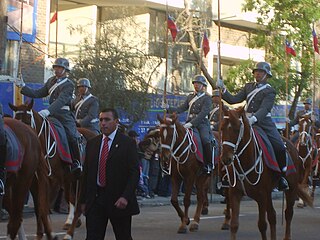
The 1st Cavalry Regiment "Grenadiers" is the senior cavalry regiment of the Chilean Army, which serves as the Horse Guards unit providing the ceremonial escort in parades and ceremonies to the President of Chile, the Supreme Commander of the Chilean Armed Forces. It provides the guard during flag raising ceremonies monthly in Santiago, the national capital. Together with the 3rd Cavalry Regiment "Hussars" it forms the remaining mounted components of the army in active service.

The Bands of the Household Division refer to the grouping of the seven military bands of the Household Division, which forms a part of the British Army's London District. The bands belong to five regiments of foot guards and two Household Cavalry regiments.

The military bands of the United Kingdom are musical units that serve for protocol and ceremonial duties as part of the British Armed Forces. They have been the basis and inspiration for many military bands in the former British Empire and the larger Commonwealth of Nations as well as musical organizations in other countries. Military musical units with British influence include United States military bands, the Japan Ground Self-Defense Force Music Corps and the Military Band of Athens. British military bands are controlled by the military music departments of the three services that compose the armed forces. These include the Royal Marines Band Service, the Royal Corps of Army Music, and the Royal Air Force Music Services. British style brass bands and carnival bands were then and are currently inspired by the British Armed Forces and its brass bands, especially of the Army's regular and reserve formations, as they follow a similar format as it relates to brass and percussion instruments.

